What exactly are sliding snow avalanches?
Sliding snow avalanches are a special type of avalanche that occur when a layer of snow slides on an underlying sliding layer, e.g. a smooth surface such as laid grass or rock slabs. The steeper the slope, the more likely the snow is to slide off. These avalanches can spread over large areas and are very difficult to predict. They are triggered by natural factors. There are different ways in which sliding snow avalanches can occur.
In spring, meltwater and rain seeping through the entire snowpack and moistening the base of the snowpack "from above" is usually the cause. In these conditions, sliding snow avalanches often occur during the typical wet snow avalanche periods and increasingly in the second half of the day.
At the height of winter, which we are currently experiencing, even if it doesn't feel like it, the snow or snow cover is usually cold and not saturated with moisture. However, the ground, especially on slopes with a humus layer (soil), has not cooled down enough before the heavy snowfall and still stores a lot of heat. As a result, the snow cover is moistened from below. This process can take place 24 hours a day. If this "smear layer" on the underside of the snowpack is thick enough and the weight of the snow can no longer be held, the snow slides downhill. Compared to slab avalanches, this process is rather slow, but very large amounts of snow often accumulate and, above all, an avalanche can occur at any time.
So if you have to pass under such "fish mouths", don't stay too long in the danger zone and keep your eyes open.
What I like to do at these times is to go to higher altitudes and the best way to do this is with lift-assisted ski tours. Many ski resorts also offer tour tickets (single trips). I usually plan a tour with several peaks or ascents. Many people shy away from putting skis on and taking them off several times, but with a bit of practice and the right technique, you will definitely have great tours with enjoyable descents. It is important that you always remove all the snow from your skis and skins . As a little tip, put the skins under your jacket on the descent, so they are slightly warmed and stick better when you put them on.
I would like to introduce you to an example tour that I did over the Christmas holidays:
We start in Gaschurn in Montafon and use the Versettlabahn to get to our starting point at an altitude of 2000m. We start with the almost 1 hour ascent to the Versettla 2368m. After a short north-west-facing descent in beautiful powder snow, we climb another 400m to reach the Madrisella and reach the 2466m summit after 1 hour. What follows is a wonderful south-west-facing descent before we return via the Matschuner and Heimbühel Joch to a short descent of around 150 m towards Vergaldatal. The gigantic view, including the Rotbühelspitze, is the icing on the cake. We are now on the classic Heimspitz ski tour and take on the last 350 vertical meters to the summit of the Heimspitze. Once we have arrived at our destination, a breathtaking descent over more than 1000 meters in beautiful, shady north-facing slopes with powder snow awaits us. All in all, a great tour with around 1300 meters of ascent and 1800 meters of descent. Except for the end of the last descent, you are always above 2000 meters and therefore in snow-sure and, above all, colder areas.
Off-piste, the terrain can be unpredictable. Steep slopes, narrow gorges and hidden obstacles can lead to dangerous situations. Thorough planning, knowledge of the terrain and the use of maps on your smartphone are therefore an absolute must. I can particularly recommend the Bergfex Touren app and the Alpenvereinaktiv app. Both apps already have a good map and tool in the free basic version to help you plan your tours.
